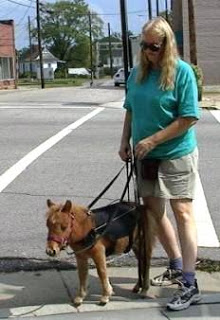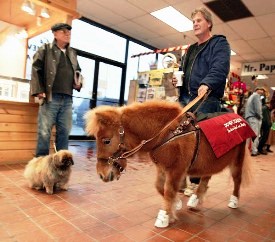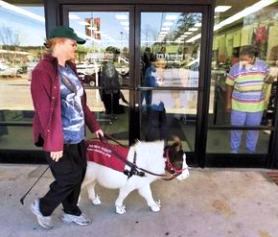Dogs
 By Julia Williams
By Julia Williams
Most of us are familiar with seeing eye dogs. These extraordinary working canines have long been used to help the blind regain their mobility and independence. But a seeing eye horse? Why yes…of course!
In 2009 there were just a handful of miniature horses being used as Guide Horses for the blind. Although the number of Guide Horses used today is still small, the demand is growing as more people begin to see the advantages of a miniature horse versus the traditional seeing eye dog. There’s even a nonprofit organization that was created specifically to provide a safe, cost-effective and reliable mobility option for visually impaired people. Founded in 1999, the Guide Horse Foundation relies on volunteers to donate, train and deliver trained Guide Horses free of charge to visually impaired individuals.
Why Use a Miniature Horse as a Blind Guide?
Guide Horses are not for everyone, but are particularly appealing to blind people who are allergic to dogs, as well as blind horse lovers, people who have Cynophobia (fear of dogs) and those who want a guide animal with a longer lifespan. Guide Horses are also a good option for individuals with physical disabilities because of their docile nature, and because they are strong enough to provide support and help the handler get up from their chair.
Guide Horses have shown promise as a viable mobility option, and people who have them say that the miniature horses have performed very well and have done a remarkable job of keeping them safe. Guide horses are also said to demonstrate excellent judgment, and are not easily distracted by crowds and people.
According to the Guide Horse Foundation, there are many characteristics of miniature horses that make them suitable to guide the blind. Among them:

• Long lifespan - Miniature Horses have an average lifespan of between 30-40 years. Guide dogs, on the other hand, are said to have a useful life between 8-12 years. Consequently, the blind person won’t need to replace their service animal as frequently, and won’t have the emotional upheaval of losing a companion they’ve bonded with.
• Better acceptance in public - Guide dogs are sometimes perceived as a pet, and as a result their blind handlers can have trouble gaining access to public places despite the Americans with Disabilities Act, which guarantees the right to public access for all service animals. Guide Horse users say this is not usually an issue with their horses. As working service animals, seeing eye horses are allowed into restaurants, businesses and public buildings like grocery stores and malls. They are even allowed to ride the bus!
• Demeanor - Trained horses are extremely calm in chaotic situations, very focused on their work and not easily distracted. Guide Horses undergo the same systematic desensitization training given to riot-control horses.
• Excellent vision - Because a horse’s eyes are on the sides of their heads, they have a range of vision of almost 350 degrees. Horses can also see exceptionally well in the dark.
• Naturally safety oriented - Horses are always on the lookout for danger, and instinctually guide their human companion along the safest and most efficient route. Guide Horses have demonstrated excellent judgment in obstacle avoidance training.
 Guide Horse Fascinating Facts
Guide Horse Fascinating Facts
If you’re like me, one of the first things you may wonder about Guide Horses is the “bathroom” issue. I’ve watched enough parades to know that most horses just do their business whenever and wherever, even if that’s in the middle of a parade route. However, I learned that guide horses can actually be “housebroken” and trained to maintain bladder control for excursions under 6 hours. On longer excursions they can be fitted with a disposable bag that catches droppings.
Because all horses require lots of fresh air, the Guide Horses live outdoors when they are not working. All Guide Horse handlers are required to have a fenced outdoor area and barn.
All Guide Horses rely on commands from their handler to tell them where to go. Guide horses must master 23 voice commands, and their handlers have to pass a test demonstrating that they have the skills to safely navigate with a guide animal.
All Guide Horses undergo rigorous training and must demonstrate 100% proficiency at keeping their handler safe in traffic. Guide Horses are trained to guide at three separate speeds – slow walk, walk and trot. The handler uses voice commands to adjust the speed.
Photos courtesy of the Guide Horse Foundation
Read more articles by Julia Williams
- Training For Blind And Deaf Dogs
Training a dog that is blind, deaf, or both, will require a great deal of patience and time to get to know the dog's limitations. Desensitization is the most most important part of training. "...Lots of individuals believe that it can be essential...
- How Equidae Helped A Hyper Horse Become A Champion
By Linda Cole Felicia Harrison just turned 16 in June, but don't let her young years fool you. She's already an accomplished horsewoman with an impressive collection of medals and buckles. Her passion for riding and love of riding and horses,...
- Skidboot, The World's Smartest Dog
By Linda Cole Skidboot became famous as the World's Smartest Dog because of his amazing tricks. However, this is not the story of Skidboot and his wonderful bag of tricks. This is a story about mutual respect, understanding and love that transformed...
- Blind Cat Rescue & Sanctuary
By Julia Williams It can be difficult for adult cats in animal shelters to find their forever home, since many people prefer to adopt a cute playful kitten instead. For cats with special needs, the chance of being adopted is almost nil. Blind Cat Rescue...
- Horse Breeds Of South America - The Criollo
Breeds Native to South AmericaThe CriolloSouth America has a number of indigenous breeds and one of these is the Criollo, the native horse of Uruguay, Brazil, Argentina and Paraguay. The breed has different names and slightly different traits according...
Dogs
Guide Horses for the Blind?

Most of us are familiar with seeing eye dogs. These extraordinary working canines have long been used to help the blind regain their mobility and independence. But a seeing eye horse? Why yes…of course!
In 2009 there were just a handful of miniature horses being used as Guide Horses for the blind. Although the number of Guide Horses used today is still small, the demand is growing as more people begin to see the advantages of a miniature horse versus the traditional seeing eye dog. There’s even a nonprofit organization that was created specifically to provide a safe, cost-effective and reliable mobility option for visually impaired people. Founded in 1999, the Guide Horse Foundation relies on volunteers to donate, train and deliver trained Guide Horses free of charge to visually impaired individuals.
Why Use a Miniature Horse as a Blind Guide?
Guide Horses are not for everyone, but are particularly appealing to blind people who are allergic to dogs, as well as blind horse lovers, people who have Cynophobia (fear of dogs) and those who want a guide animal with a longer lifespan. Guide Horses are also a good option for individuals with physical disabilities because of their docile nature, and because they are strong enough to provide support and help the handler get up from their chair.
Guide Horses have shown promise as a viable mobility option, and people who have them say that the miniature horses have performed very well and have done a remarkable job of keeping them safe. Guide horses are also said to demonstrate excellent judgment, and are not easily distracted by crowds and people.
According to the Guide Horse Foundation, there are many characteristics of miniature horses that make them suitable to guide the blind. Among them:
• Long lifespan - Miniature Horses have an average lifespan of between 30-40 years. Guide dogs, on the other hand, are said to have a useful life between 8-12 years. Consequently, the blind person won’t need to replace their service animal as frequently, and won’t have the emotional upheaval of losing a companion they’ve bonded with.
• Better acceptance in public - Guide dogs are sometimes perceived as a pet, and as a result their blind handlers can have trouble gaining access to public places despite the Americans with Disabilities Act, which guarantees the right to public access for all service animals. Guide Horse users say this is not usually an issue with their horses. As working service animals, seeing eye horses are allowed into restaurants, businesses and public buildings like grocery stores and malls. They are even allowed to ride the bus!
• Demeanor - Trained horses are extremely calm in chaotic situations, very focused on their work and not easily distracted. Guide Horses undergo the same systematic desensitization training given to riot-control horses.
• Excellent vision - Because a horse’s eyes are on the sides of their heads, they have a range of vision of almost 350 degrees. Horses can also see exceptionally well in the dark.
• Naturally safety oriented - Horses are always on the lookout for danger, and instinctually guide their human companion along the safest and most efficient route. Guide Horses have demonstrated excellent judgment in obstacle avoidance training.

If you’re like me, one of the first things you may wonder about Guide Horses is the “bathroom” issue. I’ve watched enough parades to know that most horses just do their business whenever and wherever, even if that’s in the middle of a parade route. However, I learned that guide horses can actually be “housebroken” and trained to maintain bladder control for excursions under 6 hours. On longer excursions they can be fitted with a disposable bag that catches droppings.
Because all horses require lots of fresh air, the Guide Horses live outdoors when they are not working. All Guide Horse handlers are required to have a fenced outdoor area and barn.
All Guide Horses rely on commands from their handler to tell them where to go. Guide horses must master 23 voice commands, and their handlers have to pass a test demonstrating that they have the skills to safely navigate with a guide animal.
All Guide Horses undergo rigorous training and must demonstrate 100% proficiency at keeping their handler safe in traffic. Guide Horses are trained to guide at three separate speeds – slow walk, walk and trot. The handler uses voice commands to adjust the speed.
Photos courtesy of the Guide Horse Foundation
Read more articles by Julia Williams
- Training For Blind And Deaf Dogs
Training a dog that is blind, deaf, or both, will require a great deal of patience and time to get to know the dog's limitations. Desensitization is the most most important part of training. "...Lots of individuals believe that it can be essential...
- How Equidae Helped A Hyper Horse Become A Champion
By Linda Cole Felicia Harrison just turned 16 in June, but don't let her young years fool you. She's already an accomplished horsewoman with an impressive collection of medals and buckles. Her passion for riding and love of riding and horses,...
- Skidboot, The World's Smartest Dog
By Linda Cole Skidboot became famous as the World's Smartest Dog because of his amazing tricks. However, this is not the story of Skidboot and his wonderful bag of tricks. This is a story about mutual respect, understanding and love that transformed...
- Blind Cat Rescue & Sanctuary
By Julia Williams It can be difficult for adult cats in animal shelters to find their forever home, since many people prefer to adopt a cute playful kitten instead. For cats with special needs, the chance of being adopted is almost nil. Blind Cat Rescue...
- Horse Breeds Of South America - The Criollo
Breeds Native to South AmericaThe CriolloSouth America has a number of indigenous breeds and one of these is the Criollo, the native horse of Uruguay, Brazil, Argentina and Paraguay. The breed has different names and slightly different traits according...
